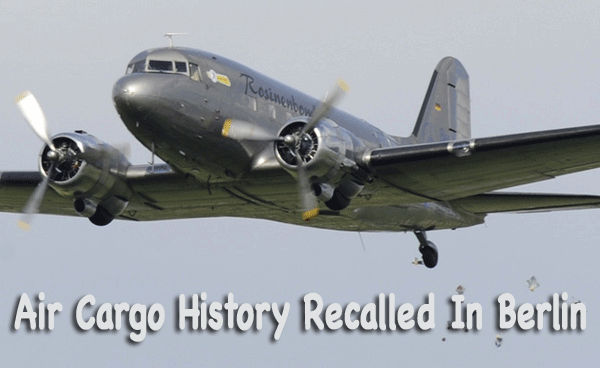
When The Berlin Airlift
took off in 1948 few people realized, that by making world headlines,
air cargo would have its media birth as intrepid military cargo pilots
supplied a city of two million for more than a year.
What happened as the Airlift continued and,
in its aftermath, is that surplus transport aircraft were snapped up and
converted into freighters by entrepreneurs everywhere.
As new air cargo companies went into (and
out of) business, air speed came to main streets around the world for
delivery of consumer and other goods as people’s popular imagination
turned to the possibilities of air cargo.
Today when the Berlin Airlift is
recalled as among the greatest and longest sustained humanitarian events
of all time, the grand dame of classic aerodromes of the last century
Tempelhof Airport (that closed to air traffic once and for all last October),
had one more go at history alive as blue skies over Berlin made the setting
perfect one month ago today, on May 12 for a grand celebration.
Berliners and other people flooded
the giant hall of the main passenger terminal to experience history together
as the last day of the famed Berlin Airlift of 1949 sixty years ago to
the day was recalled.
In 1948 and 1949, Tempelhof was
the main destination for the "Raisin Bombers" of the Berlin
Airlift, the airplanes that supplied by air the two million citizens of
Berlin during a Soviet blockade of the Western part of the city.
The history of the Berlin Airlift
came to life for the tens of thousands that followed the invitation of
Berlin's Mayor, Klaus Wowereit, to celebrate the 60th anniversary of the
end of the blockade.
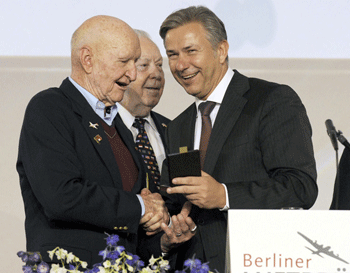 Berlin
Mayor Klaus Wowereit (at right) honored the famous American "Candy
Bomber" Gail Halvorsen, 88, at the Berlin event. Berlin
Mayor Klaus Wowereit (at right) honored the famous American "Candy
Bomber" Gail Halvorsen, 88, at the Berlin event.
It was not the sunshine, American
milkshakes and performances that drew most people to Tempelhof May 12.
"I am here to say thank you
to the veterans of the Airlift—thank you for saving the freedom
of West Berlin," was a common sentiment heard throughout the day.
Many visitors still feel deep gratitude
to the Airlift veterans.
On behalf of the citizens of Berlin,
young students presented a medal to each of the veterans during the official
commemoration ceremony.
Earlier, Franz Josef Jung, the
Federal Minister of Defense, and Mayor Wowereit had honored the 78 men
who died during the Airlift operations in a wreath-laying ceremony at
the Airlift memorial.
Jung called the Airlift "a
truly historic effort" that had “made former enemies friends.”
A hint of melancholy was in the
air during the celebration because Tempelhof Airport is now closed and
awaits re-modeling,
Yet Berliners would not be Berliners
without their distinct sense of humor. Asked what the significance of
the Airlift was, one older visitor exclaimed, with a twinkle in his eye:
"Nu ja, det war nen janz schönet
Jebrumme da am Himmel!" meaning "Well, there was quite a bit
of noise in the skies!"
Then, the man took his grandson
by the hand to meet a Berlin Airlift veteran.
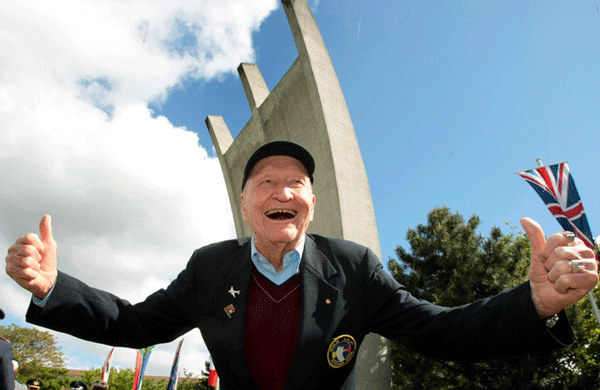
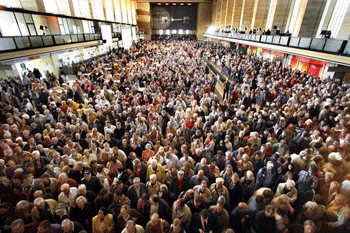 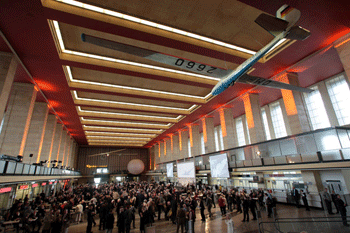
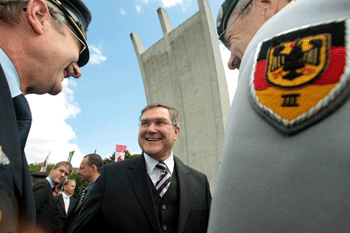
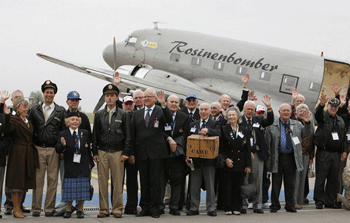
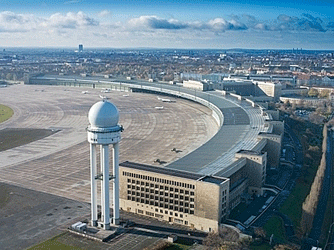 Under
the “Hunger Fork” as the sculpture is sometimes called,
the man who made “Candy Bomber” famous, 88-year-old
former Air Force Captain Gail Halvorsen returned to Berlin as
thousands flooded the great hall at Tempelhof Airport to recall
and honor the landmark air cargo movement Berlin Airlift of 1948-49
that saved a city. Under
the “Hunger Fork” as the sculpture is sometimes called,
the man who made “Candy Bomber” famous, 88-year-old
former Air Force Captain Gail Halvorsen returned to Berlin as
thousands flooded the great hall at Tempelhof Airport to recall
and honor the landmark air cargo movement Berlin Airlift of 1948-49
that saved a city.
Airlift veterans were feted by a
still grateful city for their help a long time ago by dignitaries
including Franz Josef Jung, the Federal Minister of Defense and
others, but the outpouring of everyday people to an event that
happened 60 years ago before many were even alive was both touching
and extraordinary.
Last month “Berlin showed
its heart and soul,” was one comment.
“Generation to generation
we will never forget,” was another.
|
In America, The Smithsonian National Air
and Space Museum is hosting an exhibition of historic photographs celebrating
the 60th anniversary of the Berlin Airlift.
The Berlin Airlift - a Legacy of Friendship,
will be on display at the Steven F. Udvar-Hazy Center in Chantilly, VA,
from June 15 to July 23. The exhibit has traveled to airports, military
bases and museums across the United States over the past year to highlight
the historic significance of and honor the heroes of the 1948/49 Berlin
Airlift.
German Ambassador Klaus Scharioth will introduce
the exhibition to visitors during an opening ceremony at 10:30 a.m. on
June 20 that kicks off the 5th annual Become a Pilot - Family Day and
Aviation Display at the Udvar-Hazy Center.
Visitors will also have a chance to meet
Airlift pilot Col. (ret.) USAF Gail S. Halvorsen, the "Candy Bomber"
mentioned above who today at 88 is still going strong.
A C-54 “Spirit of Freedom”,
an American aircraft deployed during the Airlift, which now serves as
a "flying museum" run by the NJ-based Berlin Airlift Historical
Foundation, will also be on display along with a German Air Force C-130
Transall aircraft.
More Info: Steven F. Udvar-Hazy Center,
14390 Air & Space Museum Parkway, Chantilly, VA. 20151 Information:
202-633-1000
The aviation display and all activities
are free, but there is a $15 fee for parking.
Geoffrey
ACD
Germany Views ATC
This time it is not
only “see you in September” – it is Auf Wiedersehen
until we meet again in an entirely new place. The
auditorium of the German Air Traffic Control Center that has served
for the past few years as venue for the gatherings of Aircargo Club
Germany just outside FRA airport is closing for reconstruction work
and getting a face-lift as well.
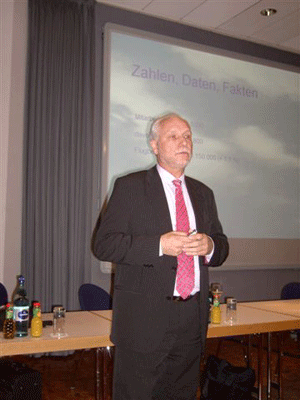 Axel
Raab, press speaker of DFS needed no mike to address the impressive
audience during the June-meeting of the German Aircargo Club. An
outstanding presentation of the institution we cooperate with in
aircargo every day–and we trust when flying anywhere–on
business or privately. Axel
Raab, press speaker of DFS needed no mike to address the impressive
audience during the June-meeting of the German Aircargo Club. An
outstanding presentation of the institution we cooperate with in
aircargo every day–and we trust when flying anywhere–on
business or privately.
So just as it breaks for Summer ‘09
and needs to find a new home as well, the 260 plus members of the
Aircargo Club Germany celebrated a nice and dedicated farewell.
At the early June event the “Guardian
Angels” of Civil Aviation ATC people addressed ACD members
and guests.
The club board arranged a barbecue
following the working half of the meeting and every detail of the
entire event was outstanding.
Only discordant note was that no one
from Fraport – the local airport operator – showed up.
But other gateways were here showing
their flag including Hamburg, Hannover, Duesseldorf, Cologne and
Nuremberg—who not only attended but also were on the floor
and spoke up.
Axel Raab presented “German
Air Traffic Control”, its organization, what the 5,300 people
do – and how German ATC has grown since it was founded in
1953.
He also encouraged a discussion about
the ATC’s future in this number one airfreight market in Europe.
Axel served as a controller and dispatcher
himself for years. Then he was the source (on a voluntary basis)
for getting stories and other information about German ATC out to
the media.
Later he was appointed PR spokesperson
for DFS (Deutsche Flugsicherung).
Technology is state of the art in
the skies above Germany and procedures are worldwide standards on
an elevated level in a highly frequented air space here at the crossroads
of Europe serving 16 international airports, and allied and German
military movements as well
When granted civil aviation rights
in 1953, DFS was started as a purely federal government agency like
in most other countries.
40 years later German Air Traffic
Control became a private institution owned 100% by the government
in 1993.
Now with the European Union in Brussels taking more control over
trade, transport and business in general, the next step invisioned
is an all European private company.
“Single European Sky”
has been realized partially with six countries participating.
But now the European Union consists
of 27 nations from Portugal to Finland and from Iceland to Cyprus.
So it will take a while–hopefully
not 40 years again–to build European Air Traffic Control into
a true Single European Sky from a tapestry of multinational as well
as multicultural and multilingual nations that are the EU of today
and tomorrow.
In the meantime government of all
EU members world support the streamlining as do airports and airlines
of course.
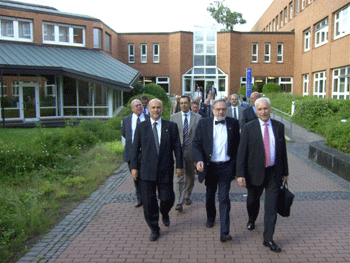 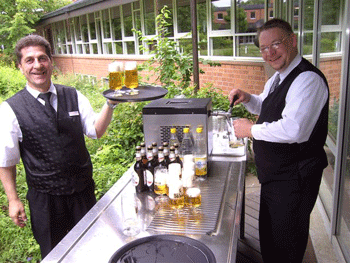
ACD members and guests enjoying the Air Traffic Control
hospitality for the last time. The future meeting location
will be closer to the airport itself, the LSG Sky Chefs facility
on the grounds of former Gateway Gardens. Good Bye, Langen.
Bratwurst, steaks, salads and many other goodies on the buffet.
Outstanding cool drinks with mixed weather.
|
ACD saw some some animated
video footage illustrating a typical 24 hours of air traffic over
Europe on a completely normal day.
Good to know that there are real experts
in the towers and in the four German control centers.
Interesting to learn during the presentation
that in order to be able to recruit about 150 new staff per annum,
DFS has to court and invite close to 3,000 applicants for the test.
The tour through the “Langen-Control
center” of DFS was as impressive as it was educational.
During the networking hour with barbecue,
wine and beer it was announced that future meetings would take place
at a new venue, the former Air Force housing area of Rhein-Main
Air Base Gateway Gardens.
LSG Sky Chefs has a brand new facility
here and offered the Aircargo Club a domicile for the monthy jour
fixe.
Program in the pipeline for 2009 Second
Half includes an economist working for a bank strongly involved
in aviation finance headlining in September.
October is still undecided, while
in November the theme will be intermodal transportation air/rail/truck
– dedicated trains, special container-like units etc.
In December, as has been tradition,
Dr. Andreas Otto, Lufthansa Cargo board member is invited to present
overall news for Christmas and year-end.
Guenter Mosler |
Getting
Moore Out Of LAX
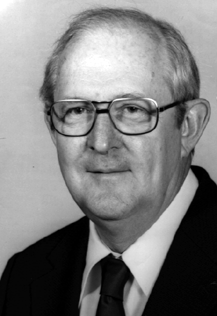 An
airport manager, the late Clifton A. Moore, who for 25 years was
Mr. Los Angeles International Airport, is honored in an exhibit
in the LAX Flight Path Museum. An
airport manager, the late Clifton A. Moore, who for 25 years was
Mr. Los Angeles International Airport, is honored in an exhibit
in the LAX Flight Path Museum.
I know Cliff Moore, he was a friend
of mine who changed the way LAX worked forever.
Once in 1981, when I told him that
Hangar One, which sits near West Imperial had a landmark plaque
that referred to the place as “Hanger One” and said
to him—"How can you preserve a place you can’t
spell."
Mr. Moore just laughed and said:
“You are right.”
He was that kind of guy, not afraid
to take correction either!
During Clifton Moore’s era of
airport management it was not uncommon for big wigs at many USA
gateways to wave off people with utter disregard.
But Moore was not like that.
So the guy who changed everything
for LAX and almost single handedly pulled the gateway into the modern
era while all the big boys of Asia/Pacific flight still served only
SFO, gets an exhibit at Flight Path.
Flight Path is a nice enough idea,
although to date the organization despite high profile and lots
of apparent support puts up a weak non-interactive website and often
( to us at least) appears more involved with itself, than the real
history of Southern California aviation.
A good example of that is a current
whoop and holler about the Howard Hughes Spruce Goose.
We are frankly sick and tired of Spruce
Goose that was both a miserable failure and today is used by as
a dumb down expedient to draw attention to places like Flight Path
that appear by that effort to be bereft of being able to raise interest
in real people, both men and woman who slugged it out and built
aviation.
For Clifton Moore, Flight Path did
not even include a picture of him on their website but maybe they
are saving that for paid admissions or something.
History alive can do better is the
thought.
In any case here is our friend Clifton
A. Moore, as we remember him fondly.
Flight Path is open from 10 a.m. to
3 p.m. on Tuesdays, Wednesdays, Thursdays and the first Saturday
of each month in the LAX Imperial Terminal, 6661 W. Imperial Highway.
Admission and parking are free.
|

Our posts on twitter this week.
June 12: NCA moves “Egypt’s Sunken Treasures,”(10-AD)
to Pacifico Yokohama for exhibit 6/ 27 to 9/23. Artifacts were submerged
off Alexandria.
June 12: African cargo shines as Nairobi hosts 15th Aviation Conference
Aug 30. Vietnam Air to #2 Asian carrier by 2015 with 104 planes.
June 12: AA boss Arpey with BOA/Merrill analysts talks expansion
into China/India/Europe Thursday. This morning AA lays off 1,500
citing weak demand.
June 12: “Bumping along the bottom,” IATA Bisignani
describes 5 months of minus air cargo numbers. "Inventories
still to high," he said.
June 12: Top Gathering...Fifth IATA Air Cargo Claims and Loss Prevention
Conference is a must! Sept. 9 Mexico City. Ajay Pande pandea@iata.org.
June 11: SIA Air Cargo lost $168.7 fiscal year. HACTL down 18.6%
May & 23.0 first five. Cathay/Dragon Cargo down 13.3% May &
16.5% first five.
June 10: At IATA KL Air China goes to 27 flights (now 10) from six
China cities to Taipei by August. Carrier to dump B747s for A330s
on some routes.
June 9: Strange case of AF 447 harkens memories of NWA 2501 loss
during 1950 . . . Flying Typers June 9 edition . . .
June 8: China Eastern & Shanghai Airlines instructed to merge.
Will control 50% of Shanghai market as World Expo Shanghai May 1-Oct
31, 2010 opens.
June 8: "Airline business to lose 9 billion in 2009—air
cargo is stabilizing." Giovanni Bisgnani IATA Sec Gen. at AGM
Kuala Lumpur.
June 7: IATA says deeper losses tomorrow. Boeing that projects 20
years forward now says it needs more data to predict next year.
Twitter Updates Daily Request to acntwitter@aircargonews.com.
|
|



